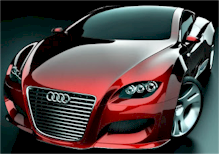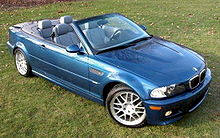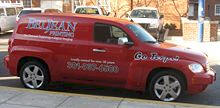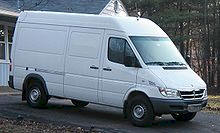I DIG® CAR BODY STYLE
-
 Automobiles'
body styles are highly variable. Some body styles remain in
production, while others become less common or obsolete. They may or
may not correlate to a car's price, size or intended market
classification. The same car model
might be available in multiple body styles comprising a model
range. Some distinctions, as with four-wheel
drive vs. SUV models or minivan vs.
MPV models, the distinction between
body style and classification can be particularly narrow.
Automobiles'
body styles are highly variable. Some body styles remain in
production, while others become less common or obsolete. They may or
may not correlate to a car's price, size or intended market
classification. The same car model
might be available in multiple body styles comprising a model
range. Some distinctions, as with four-wheel
drive vs. SUV models or minivan vs.
MPV models, the distinction between
body style and classification can be particularly narrow.While body styles have historical and technical definitions, in common usage such definitions are broad and may be ambiguous. For example, one person may call a 4-passenger sport coupé a "sports car", while another may define a sports car strictly as a two-place vehicle.
- Buggy
- A Buggy is an automobile with wheels that project beyond the
vehicle body.
- Cabrio coach or Semi-convertible
- A form of car roof, where a retractable textile cover amounts to a large sunroof. Fundamental to various older designs such as the Citroën 2CV; sometimes an option on modern cars.
- Convertible or cabriolet
- A body style with a flexible textile folding roof or rigid retracting roof — of highly variable design detail — that can convert between open-air and enclosed modes.
- Coupé

- A 2-door, 2- or 4-seat car with a fixed roof. Its doors are often longer than those of an equivalent sedan and the rear passenger area smaller; the roof may also be low. In cases where the rear seats are very small and not intended for regular use it is called a 2+2 (pronounced "two plus two"). Originally, a coupé was required to have only one side window per side, but this consideration has not been used for many years.
- Coupé utility (ute)
- the coupé utility is a passenger-car derived vehicle with coupé passenger cabin lines and an integral cargo bed.
- Crossover (or CUV)
- A loose marketing term to describe a vehicle that blends features of a SUV with features of a car — especially forgoing the body on frame construction of the SUV in favor of the car's unibody or monocoque construction. Crossovers usually borrow drivetrains and other parts from traditional cars in the same manufacturer's line.
- Estate car
- British name for a station wagon.
- Fastback
- A design where the roof slopes at a smooth angle to the tail of the car, but the rear window does not open as a separate "door".
- Hardtop
- Originally a removable solid roof on a convertible; later, also a fixed-roof car whose doors have no fixed window frames, which is designed to resemble such a convertible.
- Hatchback
- Incorporates a shared passenger and cargo volume, with rearmost accessibility via a rear third or fifth door, typically a top-hinged liftgate—and features such as fold-down rear seats to enable flexibility within the shared passenger/cargo volume. As a two-box design, the body style typically includes A, B and C-pillars, and may include a D-pillar.
- Hearse
- A converted car (often a station wagon), light truck or minivan usually used to transport the dead. Often longer and heavier than the vehicle on which they are usually based. Can sometimes double up as an ambulance in some countries, such as the United States, especially in rural areas.
- Landaulet
- A body style with a convertible top for the back seat, with the front seat either roofed or open.
- Leisure activity vehicle
- A small van, generally related to a supermini, with a second or even a third seat row, and a large, tall boot.
- Liftback
- A style of coupé or sedan with a hatchback; used especially when the rear access door is very inclined, opening more upward that outward.
- Limousine
 By
definition, a chauffeur-driven car with a (normally glass-windowed)
division between the front seats and the rear. In German, the term
simply means a sedan.
By
definition, a chauffeur-driven car with a (normally glass-windowed)
division between the front seats and the rear. In German, the term
simply means a sedan. - Minibus
- Designed to carry fewer people than a full-size bus, generally up to 16 people in multiple rows of seats. Passenger access in normally via a sliding door on one side of the vehicle. One example of a van with a minibus version available is the Ford Transit.
- Microvan
- Term for a boxy wagon-type of car that is smaller than a conventional minivan; often without rear sliding door(s). Examples are Citroën Picasso, Renault Scénic, Toyota Yaris Verso or Mercedes-Benz A-Class. In Japan, this term is used for Kei car based vans.
- Minivan
- North American term for a boxy wagon-type of car usually containing three or four rows of seats, with a capacity of six or more passengers. Often with extra luggage space also. As opposed to the larger van, the minivan was developed primarily as a passenger vehicle, though is more van-like than a station wagon. In Britain, these are generally referred to as people carriers.
- MPV
- Multi-purpose vehicle, a large car or small bus designed to be used on and off-road and easily convertible to facilitate loading of goods from facilitating carrying people.
- Notchback
- A configuration where the third box of a three-box styling configuration is less pronounced — especially where the rear deck (third box) is short or where the rear window is upright.
- People carrier or people mover
- European name to describe what is usually referred to in North America as a Minivan.
- Phaeton Pickup truck (or pickup)
- A light-duty, open-bed truck.
- Pillarless
- Usually a prefix to coupé, fastback, or hardtop; completely open at the sides when the windows are down, without a central pillar, e.g. the Sunbeam Rapier fastback coupé.
- Ragtop
- Originally an open car like a roadster, but with a soft top (cloth top) that can be raised or lowered. Unlike a convertible, it had no roll-up side windows. Now often used as slang for a convertible.
- Retractable Hardtop
- aka Coupé convertible or Coupé Cabriolet. A type of convertible forgoing a foldable textile roof in favor of a multi-segment rigid roof retracts into the lower bodywork.
- Roadster
- Originally a two-seat open car with minimal weather protection — without top or side glass — though possibly with optional hard or soft top and side curtains (i.e., without roll-up glass windows). In modern usage, the term means simply a two-seat sports car convertible, a variation of spyder.
- Sedan
- A car seating four or more with a fixed roof that is full-height up to the rear window. Known in British English as a saloon. Sedans can have 2 or 4-doors. This is the most common body style. In the U.S., this term has been used to denote a car with fixed window frames, as opposed to the hardtop style wherein the sash, if any, winds down with the glass.
- Sedan delivery
 North
American term for a vehicle similar to a wagon but without
side windows, similar to a panel truck but with two doors (one on
each side), and one or two rear doors . Often shortened to
delivery; used alone, "delivery" is presumed to be a sedan
delivery. Sedan deliveries are derived from a car platform (rather
than truck platform, like a panel van), and usually share front end
sheet metal from the same vehicle.
North
American term for a vehicle similar to a wagon but without
side windows, similar to a panel truck but with two doors (one on
each side), and one or two rear doors . Often shortened to
delivery; used alone, "delivery" is presumed to be a sedan
delivery. Sedan deliveries are derived from a car platform (rather
than truck platform, like a panel van), and usually share front end
sheet metal from the same vehicle. - Sport utility vehicle (SUV)
- Derivative of a pickup truck or 4-wheel-drive vehicle, but with fully enclosed passenger cabin interior and carlike levels of interior equipment.
- Spyder (or Spider)
- Similar to a roadster but originally with less weather protection. The term originated from a small two-seat horse cart with a folding sunshade made of four bows. With its black cloth top and exposed sides for air circulation, the top resembled a spider. Nowadays it simply means a convertible sports car.
- Shooting-brake
- Initially a vehicle used to carry shooting parties with their equipment and game; later used to describe custom-built wagons by high-end coachbuilders, subsequently synonymous with station wagon or estate; and in contemporary usage a three or five-door wagons combining features of a wagon and a coupé.
- Station wagon
- A variant of a sedan/saloon, (also known as estate or estate car) or with its roof extended rearward over a shared passenger/cargo volume; access at the back via a third or fifth door instead of a trunk lid; flexible configurations to vary passenger or cargo volume; and two or three rows of seating — in a two-box design with a A, B & C-pillar, as well as a D pillar.
- Surrey top
- Similar to the Porsche Targa top, the surrey top was developed by Triumph in 1962 for the TR4.
- T-top
- A derivative of the Targa top, called a T-bar roof, this fixed-roof design has two removable panels and retains a central narrow roof section along the front to back axis of the car (e.g. Toyota MR2 Mark I.)
- Targa top
- A semi-convertible style used on some sports cars, featuring a fully removable hard top roof panel which leaves the A and B pillars in place on the car body. (e.g. Fiat X1/9). Strictly, the term originated from and is trademarked by Porsche for a derivate of its 911 series, the Porsche 911 Targa, itself named after the famous Targa Florio rally. A related styling motif is the Targa band, sometimes called a wrapover band which is a single piece of chrome or other trim extending over the roof of the vehicle and down the sides to the bottom of the windows. It was probably named because the original Porsche Targa had such a band behind its removable roof panel in the late 60s.
- Town car (US)
- Essentially the inverse of the landaulet, a historical body style in which the front seats were open and the rear compartment closed, normally with a removable top to cover the front chauffeur's compartment. In Europe the style is also known as Sedanca de Ville, often shortened to Sedanca or de Ville. Note that the modern Lincoln Town Car derives its name, but nothing else, from this style.
- Ute
- Australian/New Zealand English term for the Coupe Utility body style (see above). Sometimes used informally to refer to any utility vehicle, particularly light trucks such as a pickup truck. In American English, sport-ute is sometimes used to refer to an SUV (see above).
- Van
 In North
America "van" refers to a truck-based commercial vehicle of the
wagon style, whether used for passenger or commercial use. Usually a
van has no windows at the side rear (panel van), although for
passenger use, side windows are included. In other parts of the
world, 'van' denotes a passenger-based wagon with no rear side
windows.
In North
America "van" refers to a truck-based commercial vehicle of the
wagon style, whether used for passenger or commercial use. Usually a
van has no windows at the side rear (panel van), although for
passenger use, side windows are included. In other parts of the
world, 'van' denotes a passenger-based wagon with no rear side
windows. - Wagon delivery
- North American term (mainly U.S. and Canada). Similar to a sedan delivery, with four doors. Sometimes shortened to delivery; used alone, "delivery" is presumed to be a sedan delivery. No longer manufactured.
- Barchetta
- Italian term for a roadster. The name means, roughly, "small boat".
- Berlina
- Italian term for a sedan.
- Berline
- French term for a sedan.
- Berlinetta
- Italian term for a sport coupé.
- Break
- French term for a station wagon.
- Camioneta
- Brazilian Portuguese term for a station wagon (specially in the state of Rio de Janeiro).
- Carrinha
- Portuguese term for a station wagon. Not used in Brazilian Portuguese.
- Espada
- Portuguese nickname for a limousine (the same word for Sword - long piece of metal). Not used in Brazilian Portuguese.
- Furgoneta
- Spanish and Polish term for a van, in the latter language almost always used in its diminutive form furgonetka.
- Furgão
- Portuguese alternative term (less used) for a van. Used in Brazilian Portuguese, most often for vans but sometimes for panel van variants of passenger cars.
- Giardinetta
- Italian term for a station wagon (not in common usage).
- Jeep
- Polish (not official), Ukrainian, Russian, Bulgarian, German, Portuguese, Hebrew and Greek term for a sport utility vehicle. Originally from the English-language jeep, of which the name's origins can be researched on the Jeep page.
- Kombi
- is a German abbreviation of "Kombinationswagen" (Combination Car) and it is German name for station wagon. Since Germany is a major producer of cars for many European countries, the term Kombi in this meaning is also used in Swedish, Czech, Slovak, Polish, Slovenian, Serbian, Bosnian, Croatian, Hungarian, Spanish, Portuguese, Bulgarian. In Afrikaans and in Australia, Kombi is also used to refer to a Volkswagen Microbus. In Brazil the word specifically refers to the VW Microbus.
- Minibus
- Danish term for Minivan.
- Perua
- Brazilian Portuguese term either designating a van (especially as spoken in the city of São Paulo) or a station wagon (in the city of Rio de Janeiro).
- Stationcar
- Danish term for station wagon.
- Turismo
- Spanish term for a sedan. Literally means tourism, used
mostly in Latin American countries.
Alternative names
Car manufacturers sometimes invent names for the body styles of their cars for the purpose of differentiating themselves from other manufacturers. These names are often, but not always, adaptations of other words and terms. The body styles themselves correlate closely to those listed above.
- Aerodeck
- Name used by Honda in the 1990s for its station wagon/estate models.
- Avant
- A name used by German maker Audi for their station wagon/estate car models.
- Bakkie
- A generic South African term for light pickup truck.
- Break
- A term used by Peugeot and Citroen to describe estates
- El Camino
- (Spanish) In English: "the road". A trademark of Chevrolet, the 1959 El Camino was a half-car (front) and half-truck (back) with low walls surrounding the bed. In other words, it used the coupé utility body style. Since the term coupé utility (nor ute) is not commonly used in North American dialects, El Camino is used by some Americans and Canadians as a generic term for any passenger car with an integral cargo bed. While the 1957 Ford Ranchero with similar body style debuted before the El Camino, it did not have the success of its Chevrolet counterpart.
- Caravan/Sports Tourer
- Used by Opel for its station wagon/estate car models.
- Combi
- Used by Škoda for its station wagon/estate car models.
- Combi coupé
- A name used by Saab for a cross between a saloon and an estate car, essentially a hatchback. Saab changed the model name to "SportCombi" (also "Sport-Hatch" or "SportWagon" in some markets) from model year 2005.
- Corniche
- Sometimes used to describe a luxury sedan or town car. Actually a trade mark of Rolls-Royce.
- Coupe Roadster
- The Mercedes-Benz name for their convertibles with a removable hardtop.
- Crosswagon
- Used by Alfa Romeo for the "All-Terrain" version of its 156 Sportwagon.
- Fordor and Tudor
- These names were coined by Ford Motor Company and introduced together with the Model A in 1928. to describe four-door and two-door bodystyles respectively. These terms were used until WWII and sporadically into the 1960s.
- Flower Car
- in US, similar to ute in Australia, i.e. generic for Chevy El Camino, Ford Ranchero, GMC Sprint/Diablo, etc.
- Grandtour
- Used by Renault and Dacia for its station wagon/estate car models.
- Hardtop Convertible
- A retractable hardtop, e.g., the 1958 Ford Skyliner or Peugeot's décapotable électrique of 1934.
- Hardtop Hatchback
- This name is used by BMW for their Mini.
- HPE
- Short for High Performance Estate, a name used by Lancia for a station wagon version of their Beta model. Resurrected for the three-door hatch version of the Lancia Delta Mk II.
- Kammback
- Originally, a car with a tapered rear that cuts off abruptly, after that shape's inventor Wunibald Kamm, commonly seen especially on sports cars. However, this usage is rare nowadays. In North America during the 1970s this style was used in the Chevrolet Vega wagon and AMC Hornet wagon, and so many think of it as another word for "station wagon" or "hatchback" respectively even though it refers to the very specific aerodynamic design of the back of the car. This style is seeing a resurgence on modern vehicles (2004 Toyota Prius and Honda Insight) in the interests of gasoline economy.
- MCV - (Multi convival vehicle)
- Term used by Romanian carmaker Dacia to refer to the estate version of their model Logan .
- Nevada
- Popular station wagon/estate version of the Renault 21, so much that people dropped the 21 when referring to it.
- Notchback
- Originally, a sedan or possibly a coupe with a backlight (rear window) which slanted backward, so that the top of the roof extended further backward than the bottom of the window. Some types of the 1958 Lincoln had this, as well as some of Ford's British cars. Later, it became used for sedans or coupes which are not fastbacks, including many hatchbacks.
- Panorama
- Used by Fiat for station wagons during the late 1970s and early 1980s, notably the 127, 128 and 131. Replaced by the Weekend designation in the mid 1980s, but kept for passenger versions of light commercial vehicles.
- Pillared Hardtop
- This name was used by Ford in the 1970s to describe its bodies which had frameless door glass like a hardtop, but retained a center pillar like a sedan. The 1972-1976 Torino sedans and wagons were of this type, as were the 1975-1979 Lincoln Town Cars. When GM introduced a similar style on their intermediates for 1973–1977, they called the two-doors Colonnade Hardtop Coupe and the four-doors, in a triumph of ad agency gibberish, Colonnade Hardtop Sedan. The 1976 Buick Century sedan used this configuration. Before Ford introduced its "Pillared Hardtops" in the early seventies, GM had the same body style available on its "C" body cars (Buick Electra 225, Oldsmobile 98 and Cadillacs) from 1965 to 1970. GM called them "semi-thin pillar sedans" as they had a slightly larger center pillars than other GM sedans (that were called "thin pillar sedans") but they had no window frames like the "thin pillar sedans" had. Chrysler's 1979-1981 R-body sedans were marketed as pillared hardtops as they had frameless windows with a thin center pillar between them.
- Prairie
- A high roofed station wagon, after the Nissan model of the same name.
- Roomster
- Name of a high roofed station wagon by Skoda
- Sport Activity Coupe (SAC)
- This name is used by BMW for their X5-based X6, which is called so because although it's an SUV, the X6 has the styling, ride height, and seating capacity of a typical coupe.
- Sport Activity Vehicle (SAV)
- This name is used by BMW for their sport utility vehicle models. It was first used on the X5 and later on the X3.
- Sport sedan or Sports sedan
- is how General Motors calls its models by Saab automobile.
- Sportshatch
- This term, which has been used by GM for several European models, has been applied to a number of body styles: A sporty liftback or hatchback and a sporty variant of a 2-door estate car (e.g. Vauxhall Magnum Sportshatch).
- Sportwagon
- A term used by Alfa Romeo to describe estates. Originally written Sport Wagon (e.g. 33 Sport Wagon) it was change into Sportwagon with the launching of the 156 Sportwagon.
- Sports Wagon
- A term used by a number of manufacturers in the North American market for their station wagon models, an example of the Sports Wagon would be the 1960s Buick Sport Wagon and the current Dodge Magnum. Auto manufacturers in recent years perceive a stigma attached to the term 'station wagon', and attempt to make these models sound more exciting.
- ST
- A term recently used by SEAT to describe (Sports Tourer).
- SW
- A term used by Peugeot to describe estates (e.g. Peugeot 407 SW) The SW models of Peugeot (without 206 SW) are station wagons with glass panoramic roof. There are also BREAK versions, which are station wagons without a glass roof. Also used by Volkswagen in the most recent generations of the Golf and Passat station wagon/estate.
- Tourer
- Used by Rover for its station wagon/estate car models. Also used by Honda for its station wagon/estate variant of the Accord in Europe.
- Touring
- Used by BMW in Europe for its station wagon/estate car models. In North America, "Sports Wagon" is used instead.
- T-Modell
- Used by Mercedes-Benz for its station wagon/estate car models.
- Travel All
- Used by International Harvester for their light truck based vans
- Traveler
- Used by International Harvester for their Scout II-based LWB station wagon
- Traveller
- Name applied to Morris's estate versions, including the Minor and the Mini-Minor. Later co-opted by Nissan and used for estate versions of the Sunny and Primera in Europe.
- Turnier
- Used by Ford in Europe for its station wagon/estate car models. Alternatively called Clipper in some markets.
- Variant
- Used by Volkswagen for its station wagon/estate car models.
- Vario
- Used by SEAT for its station wagon/estate car models.
- Verso
- Used by Toyota for MPV versions of the Yaris/Vitz, Corolla and Avensis.
- Volante
- Used by Aston Martin for convertibles.
- Weekend
- Used by Fiat for station wagons since the 1980s, including the Regata, Tempra and Marea, as well as the small Brazilian-built world car estates Duna and Palio
Sponsors
- I DIG SPORTS
24 Hours sports live from around the world - I DIG VEGAS
Give more to see and do in Vegas than you can possibly imagine. - I DIG NEWSPAPERS
I Dig Newspapers is the network for local Newspapers and International. - I DIG RADIO I Dig Radio HD the best locations for HD stations on the internet.
- I DIG CUISINE Check out the latest news about food, wine, cooking and culinary arts from the editors at idigcuisine.com
- I DIG GADGET Is designed to provided technology news on the latest gadgets, plus advances in the the technology









